Motivation Theories: Enhancing Performance in Modern Systems
VerifiedAdded on 2023/06/12
|10
|2175
|112
Essay
AI Summary
This essay explores the application of various motivation theories in the modern workplace, focusing on enhancing employee performance and overall system management. It delves into Maslow's hierarchy of needs, explaining how fulfilling basic psychological, safety, belongingness, esteem, and self-actualization needs can motivate employees. The essay also examines Herzberg's two-factor theory, distinguishing between hygiene factors that prevent dissatisfaction and motivational factors that drive job satisfaction. Furthermore, it discusses McGregor's X and Y theory, highlighting contrasting assumptions about employee motivation and how management approaches can be tailored accordingly. The report concludes that understanding and applying these theories are critical for effective people management and achieving organizational goals. Desklib provides access to this essay and many other solved assignments for students.
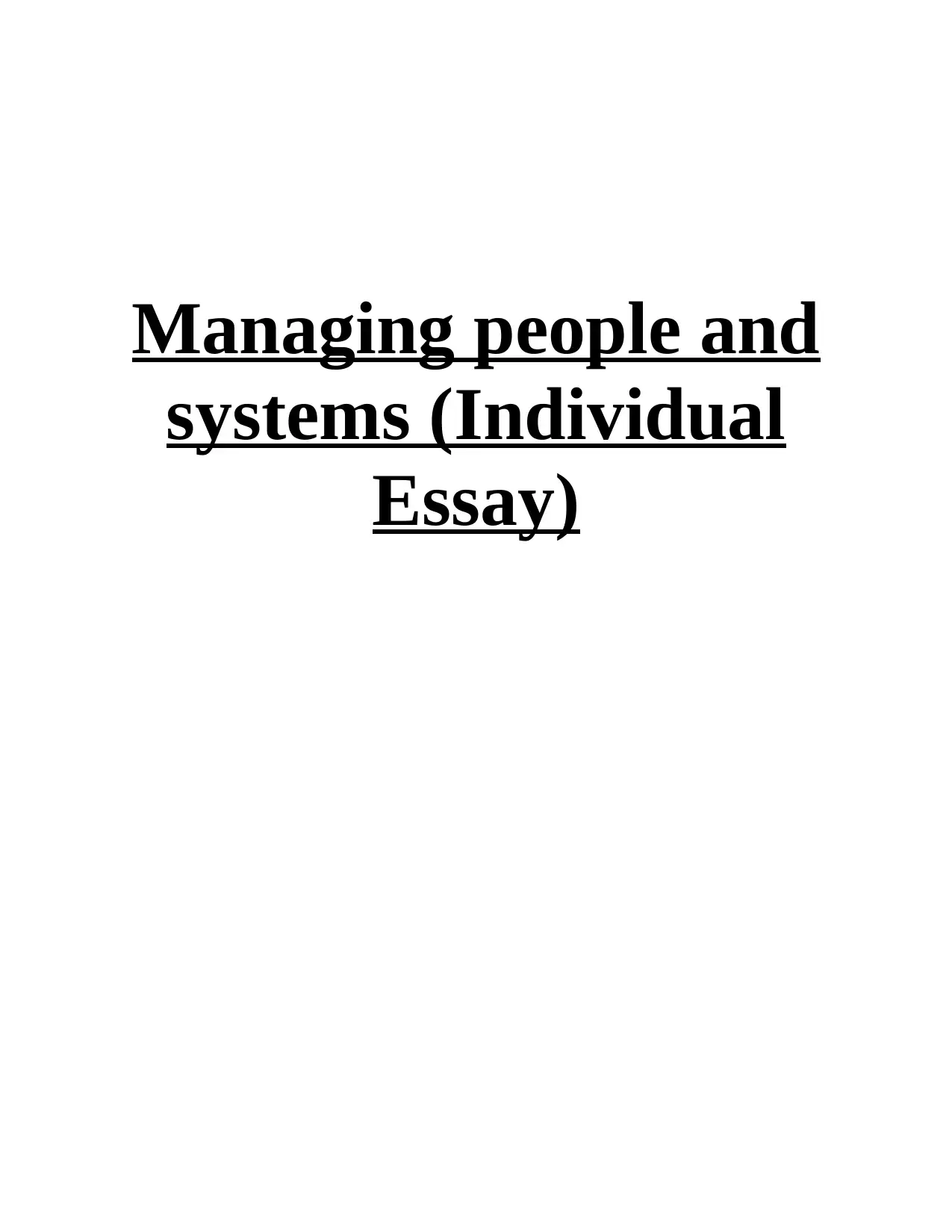
Managing people and
systems (Individual
Essay)
systems (Individual
Essay)
Paraphrase This Document
Need a fresh take? Get an instant paraphrase of this document with our AI Paraphraser
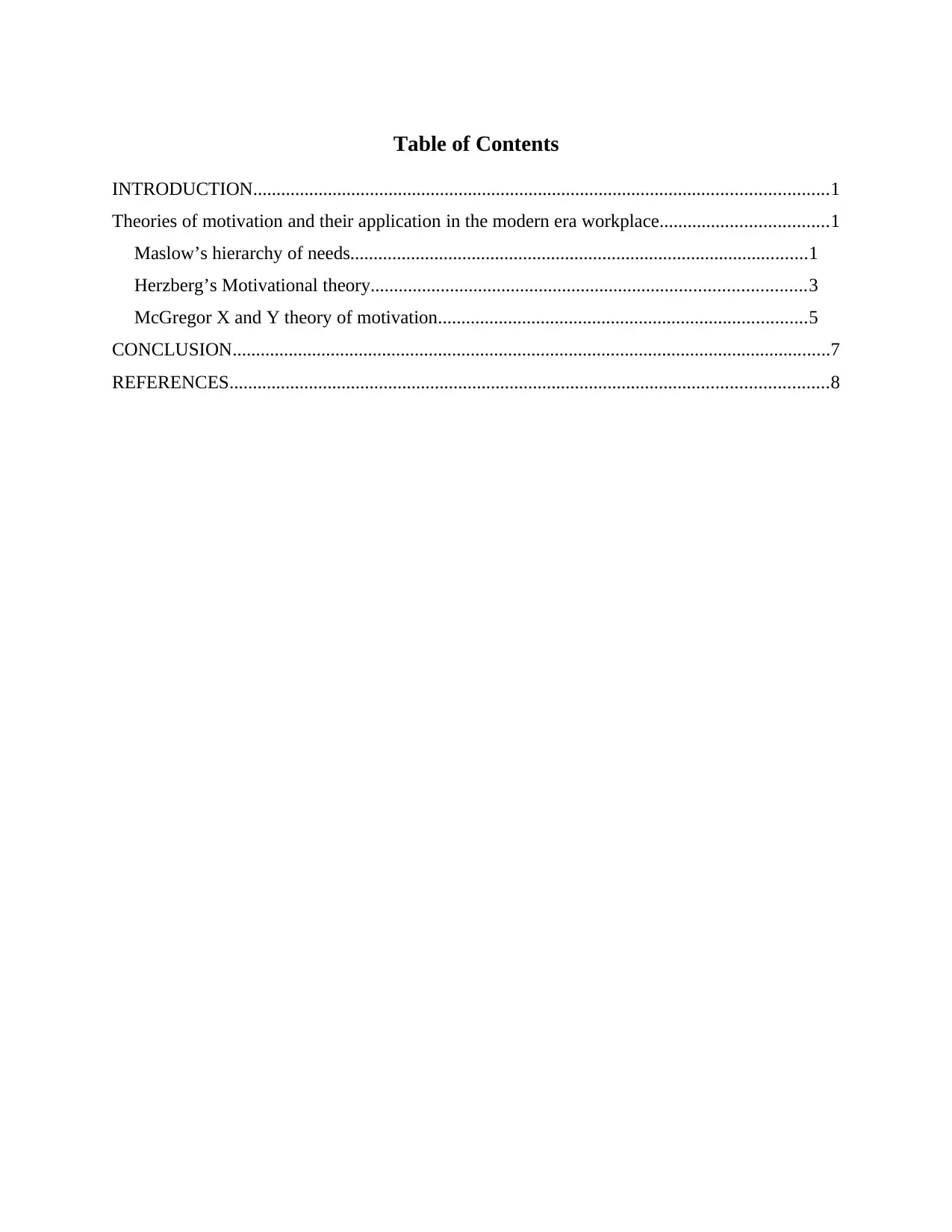
Table of Contents
INTRODUCTION...........................................................................................................................1
Theories of motivation and their application in the modern era workplace....................................1
Maslow’s hierarchy of needs..................................................................................................1
Herzberg’s Motivational theory.............................................................................................3
McGregor X and Y theory of motivation...............................................................................5
CONCLUSION................................................................................................................................7
REFERENCES................................................................................................................................8
INTRODUCTION...........................................................................................................................1
Theories of motivation and their application in the modern era workplace....................................1
Maslow’s hierarchy of needs..................................................................................................1
Herzberg’s Motivational theory.............................................................................................3
McGregor X and Y theory of motivation...............................................................................5
CONCLUSION................................................................................................................................7
REFERENCES................................................................................................................................8
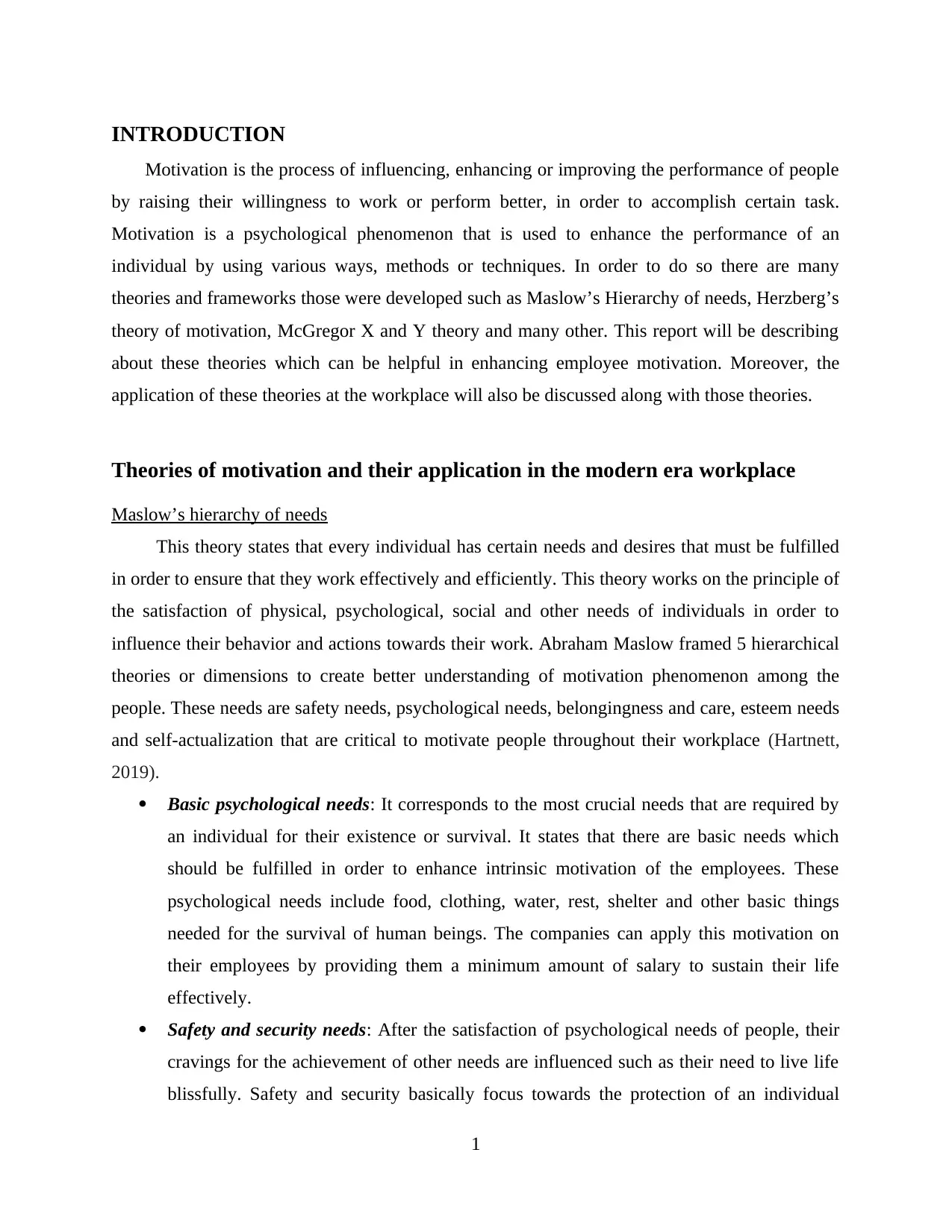
INTRODUCTION
Motivation is the process of influencing, enhancing or improving the performance of people
by raising their willingness to work or perform better, in order to accomplish certain task.
Motivation is a psychological phenomenon that is used to enhance the performance of an
individual by using various ways, methods or techniques. In order to do so there are many
theories and frameworks those were developed such as Maslow’s Hierarchy of needs, Herzberg’s
theory of motivation, McGregor X and Y theory and many other. This report will be describing
about these theories which can be helpful in enhancing employee motivation. Moreover, the
application of these theories at the workplace will also be discussed along with those theories.
Theories of motivation and their application in the modern era workplace
Maslow’s hierarchy of needs
This theory states that every individual has certain needs and desires that must be fulfilled
in order to ensure that they work effectively and efficiently. This theory works on the principle of
the satisfaction of physical, psychological, social and other needs of individuals in order to
influence their behavior and actions towards their work. Abraham Maslow framed 5 hierarchical
theories or dimensions to create better understanding of motivation phenomenon among the
people. These needs are safety needs, psychological needs, belongingness and care, esteem needs
and self-actualization that are critical to motivate people throughout their workplace (Hartnett,
2019).
Basic psychological needs: It corresponds to the most crucial needs that are required by
an individual for their existence or survival. It states that there are basic needs which
should be fulfilled in order to enhance intrinsic motivation of the employees. These
psychological needs include food, clothing, water, rest, shelter and other basic things
needed for the survival of human beings. The companies can apply this motivation on
their employees by providing them a minimum amount of salary to sustain their life
effectively.
Safety and security needs: After the satisfaction of psychological needs of people, their
cravings for the achievement of other needs are influenced such as their need to live life
blissfully. Safety and security basically focus towards the protection of an individual
1
Motivation is the process of influencing, enhancing or improving the performance of people
by raising their willingness to work or perform better, in order to accomplish certain task.
Motivation is a psychological phenomenon that is used to enhance the performance of an
individual by using various ways, methods or techniques. In order to do so there are many
theories and frameworks those were developed such as Maslow’s Hierarchy of needs, Herzberg’s
theory of motivation, McGregor X and Y theory and many other. This report will be describing
about these theories which can be helpful in enhancing employee motivation. Moreover, the
application of these theories at the workplace will also be discussed along with those theories.
Theories of motivation and their application in the modern era workplace
Maslow’s hierarchy of needs
This theory states that every individual has certain needs and desires that must be fulfilled
in order to ensure that they work effectively and efficiently. This theory works on the principle of
the satisfaction of physical, psychological, social and other needs of individuals in order to
influence their behavior and actions towards their work. Abraham Maslow framed 5 hierarchical
theories or dimensions to create better understanding of motivation phenomenon among the
people. These needs are safety needs, psychological needs, belongingness and care, esteem needs
and self-actualization that are critical to motivate people throughout their workplace (Hartnett,
2019).
Basic psychological needs: It corresponds to the most crucial needs that are required by
an individual for their existence or survival. It states that there are basic needs which
should be fulfilled in order to enhance intrinsic motivation of the employees. These
psychological needs include food, clothing, water, rest, shelter and other basic things
needed for the survival of human beings. The companies can apply this motivation on
their employees by providing them a minimum amount of salary to sustain their life
effectively.
Safety and security needs: After the satisfaction of psychological needs of people, their
cravings for the achievement of other needs are influenced such as their need to live life
blissfully. Safety and security basically focus towards the protection of an individual
1
⊘ This is a preview!⊘
Do you want full access?
Subscribe today to unlock all pages.

Trusted by 1+ million students worldwide

from any physical and emotional threats, so that they can work peacefully and harmony
in their life can be maintained (Elizabeth, 2021). The company could apply this
motivation by providing stability of income, insurance policies, grievance redresses,
pension fund and job security for their employees to satisfy their need for safety and
security.
Figure 1: Maslow's hierarchy of Needs, 2020
Affiliation and belongingness needs: The needs of a human being are never ending and
grow gradually with the fulfillment of every need. Affiliation and belongingness need
open individuals is related to their psychological need for interpersonal relations such as
friendship, affection, acceptance and belongingness. Our company could satisfy the needs
of their employees by balancing their work and family time and organizational culture to
develop a familial environment at the workplace. The fulfillment of this need would help
the employees to overcome their psychological stress, anxiety, depression, loneliness etc.
at their workplace.
Esteem needs: it is among the higher level needs which are required to fulfill the egoistic
attitude of the employees. The main elements that create esteem needs are self-respect
and self-esteem which forms the base for esteem needs (Waddington, 2021). Self-respect
is an imaginary term that occurs in the mind of people and brings a sense of
2
in their life can be maintained (Elizabeth, 2021). The company could apply this
motivation by providing stability of income, insurance policies, grievance redresses,
pension fund and job security for their employees to satisfy their need for safety and
security.
Figure 1: Maslow's hierarchy of Needs, 2020
Affiliation and belongingness needs: The needs of a human being are never ending and
grow gradually with the fulfillment of every need. Affiliation and belongingness need
open individuals is related to their psychological need for interpersonal relations such as
friendship, affection, acceptance and belongingness. Our company could satisfy the needs
of their employees by balancing their work and family time and organizational culture to
develop a familial environment at the workplace. The fulfillment of this need would help
the employees to overcome their psychological stress, anxiety, depression, loneliness etc.
at their workplace.
Esteem needs: it is among the higher level needs which are required to fulfill the egoistic
attitude of the employees. The main elements that create esteem needs are self-respect
and self-esteem which forms the base for esteem needs (Waddington, 2021). Self-respect
is an imaginary term that occurs in the mind of people and brings a sense of
2
Paraphrase This Document
Need a fresh take? Get an instant paraphrase of this document with our AI Paraphraser
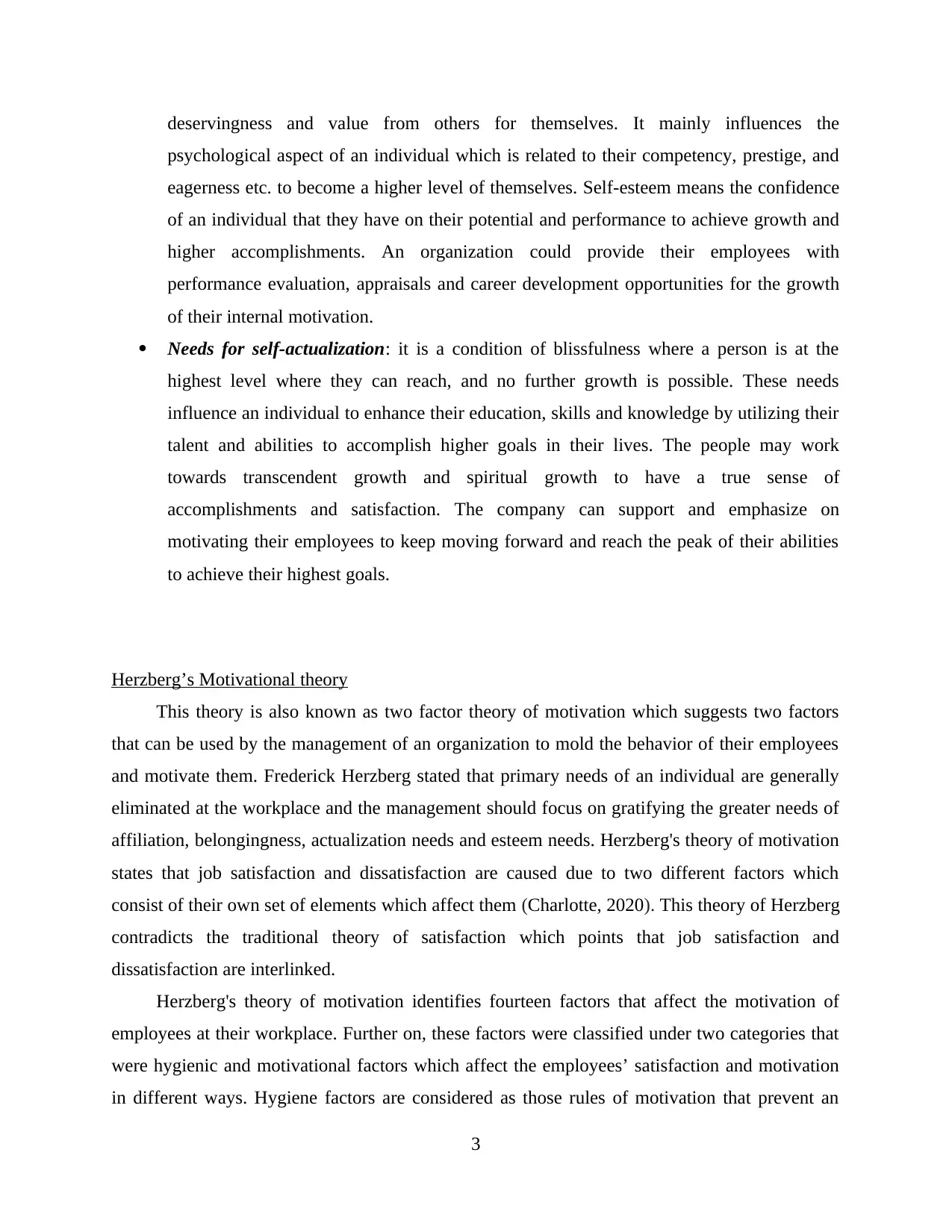
deservingness and value from others for themselves. It mainly influences the
psychological aspect of an individual which is related to their competency, prestige, and
eagerness etc. to become a higher level of themselves. Self-esteem means the confidence
of an individual that they have on their potential and performance to achieve growth and
higher accomplishments. An organization could provide their employees with
performance evaluation, appraisals and career development opportunities for the growth
of their internal motivation.
Needs for self-actualization: it is a condition of blissfulness where a person is at the
highest level where they can reach, and no further growth is possible. These needs
influence an individual to enhance their education, skills and knowledge by utilizing their
talent and abilities to accomplish higher goals in their lives. The people may work
towards transcendent growth and spiritual growth to have a true sense of
accomplishments and satisfaction. The company can support and emphasize on
motivating their employees to keep moving forward and reach the peak of their abilities
to achieve their highest goals.
Herzberg’s Motivational theory
This theory is also known as two factor theory of motivation which suggests two factors
that can be used by the management of an organization to mold the behavior of their employees
and motivate them. Frederick Herzberg stated that primary needs of an individual are generally
eliminated at the workplace and the management should focus on gratifying the greater needs of
affiliation, belongingness, actualization needs and esteem needs. Herzberg's theory of motivation
states that job satisfaction and dissatisfaction are caused due to two different factors which
consist of their own set of elements which affect them (Charlotte, 2020). This theory of Herzberg
contradicts the traditional theory of satisfaction which points that job satisfaction and
dissatisfaction are interlinked.
Herzberg's theory of motivation identifies fourteen factors that affect the motivation of
employees at their workplace. Further on, these factors were classified under two categories that
were hygienic and motivational factors which affect the employees’ satisfaction and motivation
in different ways. Hygiene factors are considered as those rules of motivation that prevent an
3
psychological aspect of an individual which is related to their competency, prestige, and
eagerness etc. to become a higher level of themselves. Self-esteem means the confidence
of an individual that they have on their potential and performance to achieve growth and
higher accomplishments. An organization could provide their employees with
performance evaluation, appraisals and career development opportunities for the growth
of their internal motivation.
Needs for self-actualization: it is a condition of blissfulness where a person is at the
highest level where they can reach, and no further growth is possible. These needs
influence an individual to enhance their education, skills and knowledge by utilizing their
talent and abilities to accomplish higher goals in their lives. The people may work
towards transcendent growth and spiritual growth to have a true sense of
accomplishments and satisfaction. The company can support and emphasize on
motivating their employees to keep moving forward and reach the peak of their abilities
to achieve their highest goals.
Herzberg’s Motivational theory
This theory is also known as two factor theory of motivation which suggests two factors
that can be used by the management of an organization to mold the behavior of their employees
and motivate them. Frederick Herzberg stated that primary needs of an individual are generally
eliminated at the workplace and the management should focus on gratifying the greater needs of
affiliation, belongingness, actualization needs and esteem needs. Herzberg's theory of motivation
states that job satisfaction and dissatisfaction are caused due to two different factors which
consist of their own set of elements which affect them (Charlotte, 2020). This theory of Herzberg
contradicts the traditional theory of satisfaction which points that job satisfaction and
dissatisfaction are interlinked.
Herzberg's theory of motivation identifies fourteen factors that affect the motivation of
employees at their workplace. Further on, these factors were classified under two categories that
were hygienic and motivational factors which affect the employees’ satisfaction and motivation
in different ways. Hygiene factors are considered as those rules of motivation that prevent an
3
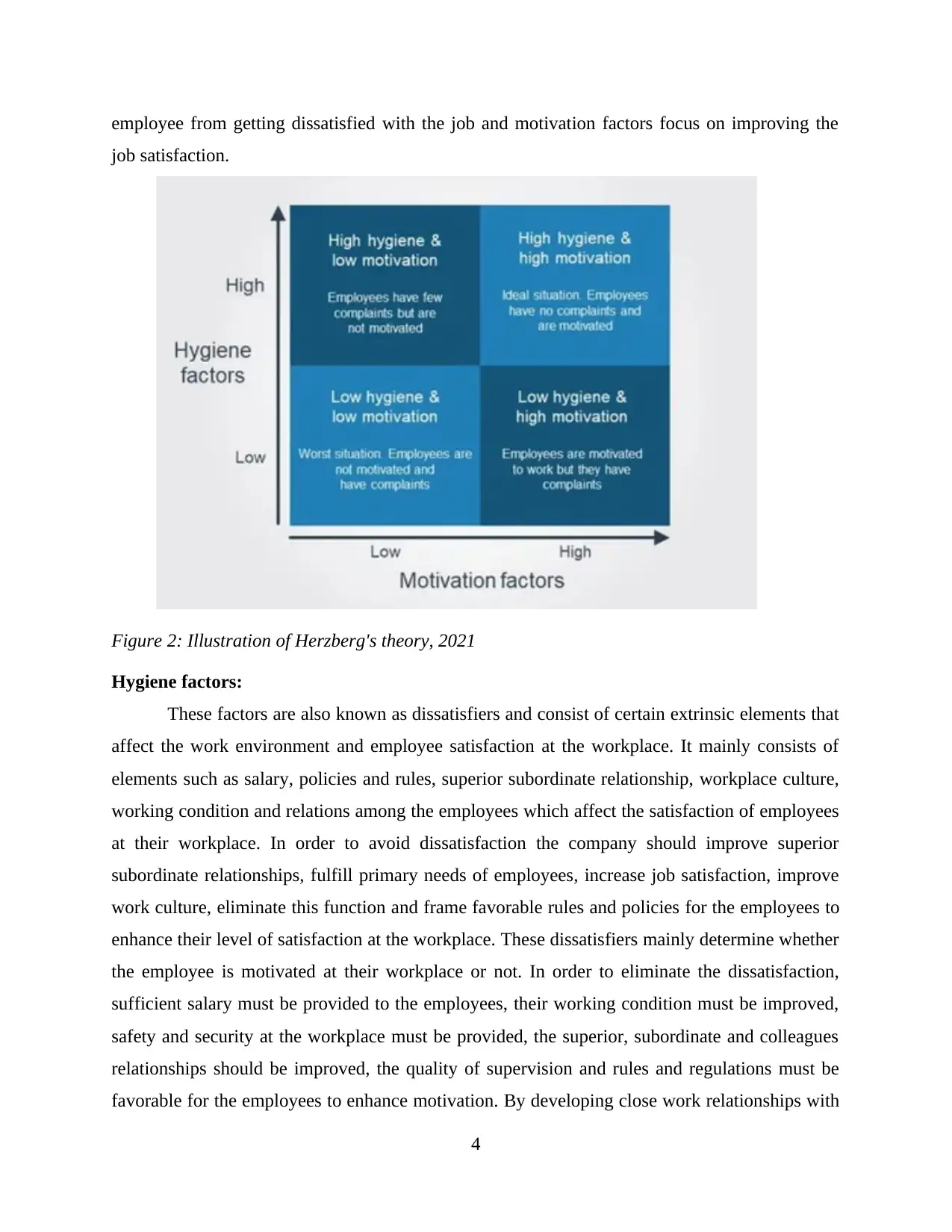
employee from getting dissatisfied with the job and motivation factors focus on improving the
job satisfaction.
Figure 2: Illustration of Herzberg's theory, 2021
Hygiene factors:
These factors are also known as dissatisfiers and consist of certain extrinsic elements that
affect the work environment and employee satisfaction at the workplace. It mainly consists of
elements such as salary, policies and rules, superior subordinate relationship, workplace culture,
working condition and relations among the employees which affect the satisfaction of employees
at their workplace. In order to avoid dissatisfaction the company should improve superior
subordinate relationships, fulfill primary needs of employees, increase job satisfaction, improve
work culture, eliminate this function and frame favorable rules and policies for the employees to
enhance their level of satisfaction at the workplace. These dissatisfiers mainly determine whether
the employee is motivated at their workplace or not. In order to eliminate the dissatisfaction,
sufficient salary must be provided to the employees, their working condition must be improved,
safety and security at the workplace must be provided, the superior, subordinate and colleagues
relationships should be improved, the quality of supervision and rules and regulations must be
favorable for the employees to enhance motivation. By developing close work relationships with
4
job satisfaction.
Figure 2: Illustration of Herzberg's theory, 2021
Hygiene factors:
These factors are also known as dissatisfiers and consist of certain extrinsic elements that
affect the work environment and employee satisfaction at the workplace. It mainly consists of
elements such as salary, policies and rules, superior subordinate relationship, workplace culture,
working condition and relations among the employees which affect the satisfaction of employees
at their workplace. In order to avoid dissatisfaction the company should improve superior
subordinate relationships, fulfill primary needs of employees, increase job satisfaction, improve
work culture, eliminate this function and frame favorable rules and policies for the employees to
enhance their level of satisfaction at the workplace. These dissatisfiers mainly determine whether
the employee is motivated at their workplace or not. In order to eliminate the dissatisfaction,
sufficient salary must be provided to the employees, their working condition must be improved,
safety and security at the workplace must be provided, the superior, subordinate and colleagues
relationships should be improved, the quality of supervision and rules and regulations must be
favorable for the employees to enhance motivation. By developing close work relationships with
4
⊘ This is a preview!⊘
Do you want full access?
Subscribe today to unlock all pages.

Trusted by 1+ million students worldwide
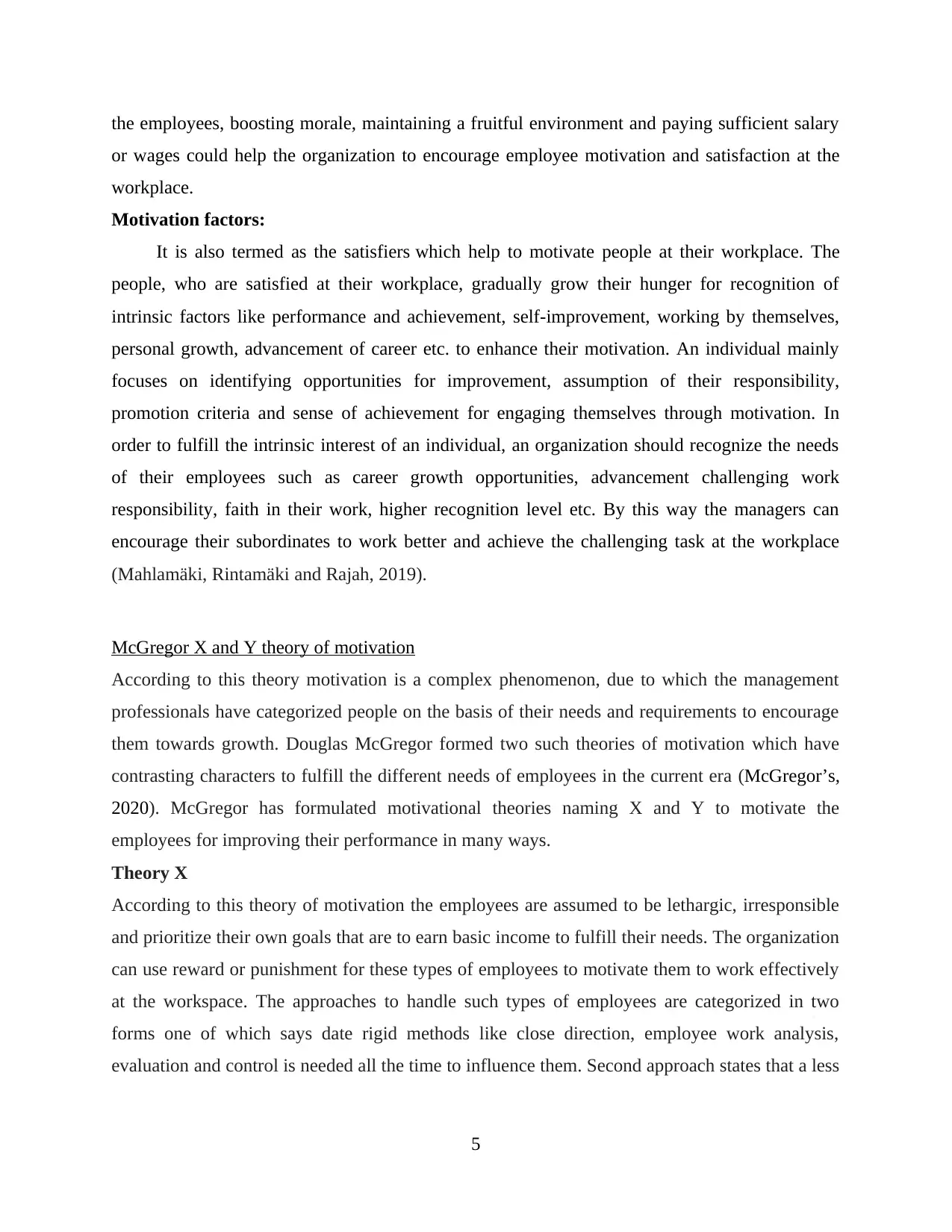
the employees, boosting morale, maintaining a fruitful environment and paying sufficient salary
or wages could help the organization to encourage employee motivation and satisfaction at the
workplace.
Motivation factors:
It is also termed as the satisfiers which help to motivate people at their workplace. The
people, who are satisfied at their workplace, gradually grow their hunger for recognition of
intrinsic factors like performance and achievement, self-improvement, working by themselves,
personal growth, advancement of career etc. to enhance their motivation. An individual mainly
focuses on identifying opportunities for improvement, assumption of their responsibility,
promotion criteria and sense of achievement for engaging themselves through motivation. In
order to fulfill the intrinsic interest of an individual, an organization should recognize the needs
of their employees such as career growth opportunities, advancement challenging work
responsibility, faith in their work, higher recognition level etc. By this way the managers can
encourage their subordinates to work better and achieve the challenging task at the workplace
(Mahlamäki, Rintamäki and Rajah, 2019).
McGregor X and Y theory of motivation
According to this theory motivation is a complex phenomenon, due to which the management
professionals have categorized people on the basis of their needs and requirements to encourage
them towards growth. Douglas McGregor formed two such theories of motivation which have
contrasting characters to fulfill the different needs of employees in the current era (McGregor’s,
2020). McGregor has formulated motivational theories naming X and Y to motivate the
employees for improving their performance in many ways.
Theory X
According to this theory of motivation the employees are assumed to be lethargic, irresponsible
and prioritize their own goals that are to earn basic income to fulfill their needs. The organization
can use reward or punishment for these types of employees to motivate them to work effectively
at the workspace. The approaches to handle such types of employees are categorized in two
forms one of which says date rigid methods like close direction, employee work analysis,
evaluation and control is needed all the time to influence them. Second approach states that a less
5
or wages could help the organization to encourage employee motivation and satisfaction at the
workplace.
Motivation factors:
It is also termed as the satisfiers which help to motivate people at their workplace. The
people, who are satisfied at their workplace, gradually grow their hunger for recognition of
intrinsic factors like performance and achievement, self-improvement, working by themselves,
personal growth, advancement of career etc. to enhance their motivation. An individual mainly
focuses on identifying opportunities for improvement, assumption of their responsibility,
promotion criteria and sense of achievement for engaging themselves through motivation. In
order to fulfill the intrinsic interest of an individual, an organization should recognize the needs
of their employees such as career growth opportunities, advancement challenging work
responsibility, faith in their work, higher recognition level etc. By this way the managers can
encourage their subordinates to work better and achieve the challenging task at the workplace
(Mahlamäki, Rintamäki and Rajah, 2019).
McGregor X and Y theory of motivation
According to this theory motivation is a complex phenomenon, due to which the management
professionals have categorized people on the basis of their needs and requirements to encourage
them towards growth. Douglas McGregor formed two such theories of motivation which have
contrasting characters to fulfill the different needs of employees in the current era (McGregor’s,
2020). McGregor has formulated motivational theories naming X and Y to motivate the
employees for improving their performance in many ways.
Theory X
According to this theory of motivation the employees are assumed to be lethargic, irresponsible
and prioritize their own goals that are to earn basic income to fulfill their needs. The organization
can use reward or punishment for these types of employees to motivate them to work effectively
at the workspace. The approaches to handle such types of employees are categorized in two
forms one of which says date rigid methods like close direction, employee work analysis,
evaluation and control is needed all the time to influence them. Second approach states that a less
5
Paraphrase This Document
Need a fresh take? Get an instant paraphrase of this document with our AI Paraphraser

strict and self-driven form of motivation must be enclosed at the workplace so that higher levels
of motivation and employee engagement at the workplace can be achieved.
Figure 3: McGregor model of Motivation, 2020
Theory Y
The manager using this form of theory assumes that the workers are highly motivated,
opportunistic, ecstatic, and competitive and want to improve themselves with their whole hearted
devotion at the workplace (Olaniran and et. al., 2022). The employees under this category are
highly responsible, dedicated to work and undertake tasks that can help them to grow. This form
of employees does not need close observation of their work and they take responsibility for
whatever they do. The management of a company should appreciate the work of this type of
employee and should rely on their work for completing complex assignments and tasks at the
workplace.
6
of motivation and employee engagement at the workplace can be achieved.
Figure 3: McGregor model of Motivation, 2020
Theory Y
The manager using this form of theory assumes that the workers are highly motivated,
opportunistic, ecstatic, and competitive and want to improve themselves with their whole hearted
devotion at the workplace (Olaniran and et. al., 2022). The employees under this category are
highly responsible, dedicated to work and undertake tasks that can help them to grow. This form
of employees does not need close observation of their work and they take responsibility for
whatever they do. The management of a company should appreciate the work of this type of
employee and should rely on their work for completing complex assignments and tasks at the
workplace.
6

CONCLUSION
From the above report it has been concluded that motivation is a critical factor to enhance
the performance of people at the workplace. The above report helps in explaining about certain
theories of motivation such as Maslow's hierarchy of needs which describes basic psychological
needs, safety needs, affiliation and belongingness, esteem needs and self-actualization needs.
Moreover, this report had elaborated hospice motivation theory which consists of hygiene factors
and motivation factors to increase the satisfaction level of employees at the workplace.
McGregor’s X and Y theory of motivation has also been explained in the above report which
details theory X and Y for motivating different types of people at the workplace.
7
From the above report it has been concluded that motivation is a critical factor to enhance
the performance of people at the workplace. The above report helps in explaining about certain
theories of motivation such as Maslow's hierarchy of needs which describes basic psychological
needs, safety needs, affiliation and belongingness, esteem needs and self-actualization needs.
Moreover, this report had elaborated hospice motivation theory which consists of hygiene factors
and motivation factors to increase the satisfaction level of employees at the workplace.
McGregor’s X and Y theory of motivation has also been explained in the above report which
details theory X and Y for motivating different types of people at the workplace.
7
⊘ This is a preview!⊘
Do you want full access?
Subscribe today to unlock all pages.

Trusted by 1+ million students worldwide

REFERENCES
Books and Journals
Hartnett, M., 2019. Theories of motivation in open and distance education. In Open and Distance
Education Theory Revisited (pp. 105-113). Springer, Singapore.
Mahlamäki, T., Rintamäki, T. and Rajah, E., 2019. The role of personality and motivation on key
account manager job performance. Industrial Marketing Management, 83. pp.174-184.
Olaniran, A. and et. al., 2022. Factors influencing motivation and job satisfaction of community
health workers in Africa and Asia—A multi‐country study. The International Journal of
Health Planning and Management, 37(1). pp.112-132.
Waddington, J., 2021. Motivation in Practice. In Research Questions in Language Education and
Applied Linguistics (pp. 123-127). Springer, Cham.
Online:-
Charlotte Nickerson, 2020. Herzberg’s Theory of Motivation. [Online] Available through, <
https://www.thoughtco.com/maslows-hierarchy-of-needs>
Elizabeth Hopper, 2021. Maslow’s Hierarchy of Needs. [Online] Available through, <
https://www.thoughtco.com/maslows-hierarchy-of-needs-4582571>
McGregor’s Theory X and Y of Motivation, 2020. [Online] Available through,
https://medium.com/the-enterprise-diary/mcgregors-theory-x-and-theory-y-of-motivation
8
Books and Journals
Hartnett, M., 2019. Theories of motivation in open and distance education. In Open and Distance
Education Theory Revisited (pp. 105-113). Springer, Singapore.
Mahlamäki, T., Rintamäki, T. and Rajah, E., 2019. The role of personality and motivation on key
account manager job performance. Industrial Marketing Management, 83. pp.174-184.
Olaniran, A. and et. al., 2022. Factors influencing motivation and job satisfaction of community
health workers in Africa and Asia—A multi‐country study. The International Journal of
Health Planning and Management, 37(1). pp.112-132.
Waddington, J., 2021. Motivation in Practice. In Research Questions in Language Education and
Applied Linguistics (pp. 123-127). Springer, Cham.
Online:-
Charlotte Nickerson, 2020. Herzberg’s Theory of Motivation. [Online] Available through, <
https://www.thoughtco.com/maslows-hierarchy-of-needs>
Elizabeth Hopper, 2021. Maslow’s Hierarchy of Needs. [Online] Available through, <
https://www.thoughtco.com/maslows-hierarchy-of-needs-4582571>
McGregor’s Theory X and Y of Motivation, 2020. [Online] Available through,
https://medium.com/the-enterprise-diary/mcgregors-theory-x-and-theory-y-of-motivation
8
1 out of 10
Related Documents
Your All-in-One AI-Powered Toolkit for Academic Success.
+13062052269
info@desklib.com
Available 24*7 on WhatsApp / Email
![[object Object]](/_next/static/media/star-bottom.7253800d.svg)
Unlock your academic potential
Copyright © 2020–2025 A2Z Services. All Rights Reserved. Developed and managed by ZUCOL.





